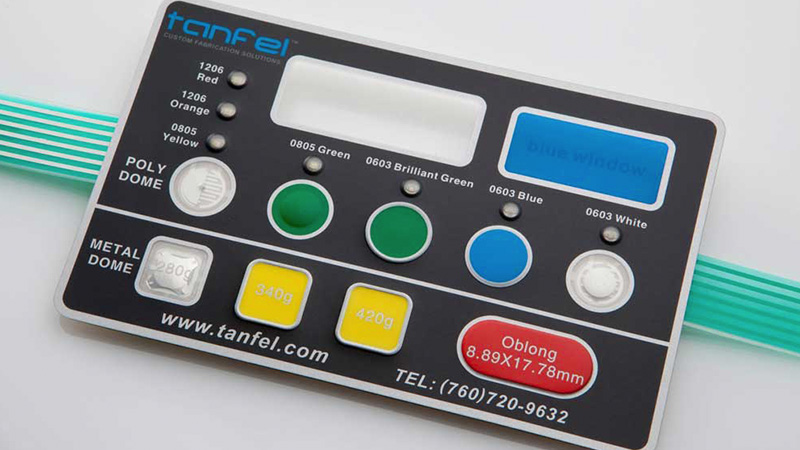Membrane Switches vs. Conventional Switches: What You Need to Know
Membrane Switches vs. Conventional Switches: What You Need to Know
Blog Article
Membrane Switch Innovation: The Key to Reliable and Economical User Interfaces
Membrane switch innovation has arised as an essential part in the design of user interfaces, supplying both integrity and cost-effectiveness across a diverse range of applications. As we discover the complex benefits of membrane buttons, their potential for innovation increases concerns regarding future applications and developing trends.
Understanding Membrane Switch Innovation
Membrane layer switch modern technology is an extensively utilized interface remedy in various digital tools, offering a seamless blend of functionality and layout. This modern technology includes several layers of materials, generally consisting of a visuals overlay, spacer layer, and a circuit layer. The visuals overlay presents the user interface elements, while the spacer layer separates the circuit layer from the overlay till a customer triggers a button.
When pressure is applied to the overlay, the circuit layer completes the electric circuit, sending a signal to the device. This device allows for different arrangements, including tactile responses and backlighting options, improving individual communication. Membrane layer switches are usually made utilizing durable products such as polyester or polycarbonate, guaranteeing longevity and resistance to environmental aspects like dampness and dirt.
The flexibility of membrane layer changes enables their application in varied sectors, including medical gadgets, customer electronics, and industrial controls. Their small style enables for assimilation into space-constrained environments, providing an efficient interface without endangering aesthetic charm. Comprehending the ins and outs of membrane button innovation is essential for makers and developers seeking to produce reputable and efficient human-machine interfaces.
Key Advantages of Membrane Layer Buttons
While different interface solutions exist, membrane changes deal unique advantages that make them a preferred choice in countless applications. Among the main benefits is their resilience; membrane layer switches are made to hold up against extreme environmental conditions, including moisture, dirt, and temperature fluctuations, making certain resilient performance. This strength considerably lowers the need for frequent substitutes, thus reducing overall maintenance prices.

Moreover, membrane layer switches are lightweight and small, making them ideal for applications where room is limited. Their low-profile style adds to a streamlined appearance without compromising performance.
Cost-effectiveness is also a notable advantage, as the manufacturing procedure for membrane layer switches has a tendency to be much less expensive compared to traditional mechanical buttons. This price, integrated with their reliability and convenience of setup, settings membrane switches as a functional remedy for a vast array of sectors looking for effective and effective interface.
Applications Across Various Industries
How do membrane buttons adapt to the diverse demands of numerous markets? Membrane button innovation is significantly identified for its flexibility, making it appropriate for a large array of applications throughout multiple fields.
In customer electronics, membrane layer switches give a portable remedy additional hints for remotes and home appliances, enhancing customer experience with intuitive style. In addition, the commercial market leverages membrane switches for machinery control panels, taking advantage of their resistance to severe settings, such as dampness and dirt.
Army and aerospace applications likewise utilize membrane buttons for their reliability and capacity to stand up to severe problems, guaranteeing functional efficiency in critical situations. The food and drink industry takes on these switches for automated systems, where sanitation and ease of procedure are critical (membrane switch). Ultimately, membrane switches are tailored to fulfill the one-of-a-kind needs of each market, confirming their vital role in modern-day innovation interfaces
Layout and Customization Alternatives

In the world of membrane button modern technology, design and customization choices play a pivotal role in improving capability and user interaction. These switches can be tailored to meet specific functional needs and visual choices, making them functional elements in various applications.
Among the key modification alternatives is the layout of the switch itself, which can be designed to suit special interface and ergonomic factors to consider. By changing the form, size, and plan of buttons, manufacturers can develop instinctive designs that assist in ease of use. In addition, the consolidation of various colors and visuals overlays permits branding and improved exposure, ensuring that individuals can quickly determine features.
Moreover, membrane buttons can be engineered with different tactile responses mechanisms, such as elevated buttons or distinct clicks, to boost the user experience. Various products can additionally be selected for longevity and environmental resistance, addressing aspects such as dampness, temperature changes, and chemical direct exposure.
Inevitably, the comprehensive layout and modification choices offered in membrane layer button modern technology equip organizations to develop customized solutions that not only meet practical demands however also straighten with their branding and functional needs.

Future Patterns in Membrane Switches
As membrane switch technology site web continues to advance, future patterns are significantly concentrated on boosting user experience and integrating sophisticated functionalities. One substantial fad is the integration of touch-sensitive and capacitive modern technologies into typical membrane layer switches. This growth permits for even more instinctive customer interfaces, supplying tactile comments while keeping a sleek layout.
An additional arising fad is the use of eco-friendly products, driven by the expanding need for lasting manufacturing methods. Producers are seeking to decrease their carbon footprint by making use of recyclable substrates and low-impact inks, lining up with global sustainability goals.
Furthermore, helpful site the rise of the Web of Things (IoT) is prompting the consolidation of smart attributes right into membrane layer switches. Enhanced connection choices will allow tools to connect with each various other, allowing for seamless integration right into broader systems.
Furthermore, developments in printing technologies, such as digital printing, are permitting higher design adaptability and modification. This allows producers to generate detailed layouts and lively shades cost-effectively.

Verdict
In final thought, membrane layer switch modern technology stands for a crucial technology in user interface design, providing considerable benefits in sturdiness, modification, and cost-effectiveness. As developments proceed to emerge, specifically in touch-sensitive interfaces and lasting products, the possibility for membrane layer switches to boost user experience and functionality remains promising.
Report this page